市场营销外文翻译
- 格式:doc
- 大小:55.50 KB
- 文档页数:12
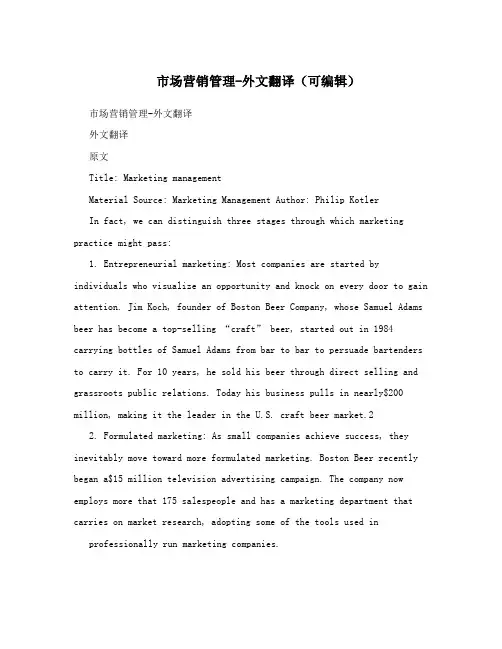
市场营销管理-外文翻译(可编辑)市场营销管理-外文翻译外文翻译原文Title: Marketing managementMaterial Source: Marketing Management Author: Philip KotlerIn fact, we can distinguish three stages through which marketing practice might pass:1. Entrepreneurial marketing: Most companies are started by individuals who visualize an opportunity and knock on every door to gain attention. Jim Koch, founder of Boston Beer Company, whose Samuel Adams beer has become a top-selling “craft” beer, started out in 1984 carrying bottles of Samuel Adams from bar to bar to persuade bartenders to carry it. For 10 years, he sold his beer through direct selling and grassroots public relations. Today his business pulls in nearly$200 million, making it the leader in the U.S. craft beer market.22. Formulated marketing: As small companies achieve success, they inevitably move toward more formulated marketing. Boston Beer recently began a$15 million television advertising campaign. The company now employs more that 175 salespeople and has a marketing department that carries on market research, adopting some of the tools used in professionally run marketing companies.3. Coordinated marketing: Many large companies get stuck in formulated marketing, poring over the latest ratings, scanning research reports, trying to fine-tune dealer relations and advertising messages. These companies lack the creativity and passion of the guerrilla marketers in the entrepreneurial stage. Their brand and product managers need to start living with their customers and visualizing new ways to add value to their customers’ lives.The bottom line is that effective marketing can take many forms. Although it is easier to study the formulated side which will occupy most of our attention in this book, we will also see how creativity and passion can be used by today and tomorrow’s marketing managers.Marketers and ProspectsA marketer is someone who is seeking a response attention, a purchase, a vote, a donation from another party, called the prospect. If two parties are seeking to sell something to each other, both are marketers.Needs, Wants, and DemandsThe successful marketer will try to understand the target market’s needs, wants, and demands. Needs describes basic human requirements such as food, air, water, clothing, and shelter. People also have strong needs for recreation, education, and entertainment. These needs become wants when they are directed to specific objects that might satisfy the need. An American needs food but wants a hamburger, French fries, and a soft drink. A person in Mauritius needs food butwants a mango, rice, lentils, and beans. Clearly, wants are shaped by one’s society.Demands are wants for specific products backed by an ability to pay. Many people want a Mercedes; only a few are able and willing to buy one. Companies must measure not only how many people want their product, but also how many would actually be willing and able to buy it.However, marketers do not create needs: Needs that preexists marketers. Marketers, along with other societal influences, influence wants. Marketers might promote the idea that a Mercedes would satisfy a person’s need for social status. They do not, how-ever, create the need for social status.Product or OfferingPeople satisfy their needs and wants with products. A product is any offering that we can satisfy a need or want, such as one of the 10 basic offerings ofgoods,services,experi-ences,events,persons,places,properties,organizations,information,and ideas.A brand is an offering from a known source. A brand name such as McDonald’s carries many associations in the minds of people: hamburgers, fun, children, fast food, golden arches. These associations make up the brand image. All companies strive to build a strong, favorable brand image.Value and SatisfactionIn terms of marketing, the product or offering will be successful if it delivers value and satisfaction to the target buyer. The buyer chooses between different offerings on the basis of which is perceived to deliver the most value. We define value as a ratio between what the customer gets and what he gives. The customer gets benefits and assumes costs, as shown in this equation.A customer choosing between two value offerings, V1and V2, will examine the ratio V1/V2.She will favor V1 if the ratio is larger than one; she will favor V2 if the ratio is smaller than one; and she will be indifferent if the ratio equals one.Exchange and TransactionsExchange, the core of marketing, involves obtaining a desiredproduct from someone by offering something in return. For exchange potential to exist, five conditions must be satisfied:1. There are at least two parties.2. Each party has something that might be of value to the other party.3. Each party is capable of communication and delivery. Marketing Tasks 74. Each party is free to accept or reject the exchange offer.5. Each party believes it is appropriate or desirable to deal with the other party.Whether exchange actually takes place depends upon whether the two parties can agree on terms that will leave them both better off or atleast not worse off than before. Exchange is a value-creating process because it normally leaves both parties better off.Note that exchange is a process rather than an event. Two partiesare engaged in exchange if they are negotiating?trying to arrive at mutually agreeable terms. When an agreement is reached, we say that a transaction takes place. A transaction involves at least two things of value, agreed-upon conditions, a time of agreement, and a place of agreement usually a legal system exists to support and enforce compliance among of transactors. However, transactions do not require money as one of the traded values. A barter transaction, for example, involves trading goods or services for other goods or services.Note also that a transaction differs from a transfer. In a transfer, A gives a gift, a subsidy, or a charitable contribution to B but receives nothing tangible in return. Transfer behavior can also be understood through the concept of exchange. Typically, the transfer expects something in exchange for his or her gift?for example, gratitude or seeing changed behavior in the recipient. Professional fund-raisers providebenefits to donors, such as thank-you notes. Contemporary marketers have broadened the concept of marketing to include the study of transfer behavior as well as transaction behavior.Marketing consists of actions undertaken to elicit desired responses from a tar-get audience. To effecting successful exchanges, marketersanalyze what each party expects from the transaction. SupposeCaterpillar, the world’s largest manufacturer of earth-moving equipment, researches the benefits that a typical construction company wantswhen it buys such equipment. The items shown on the prospect want listin Figure 1-2 are not equally important and may vary from buyer to buyer. One of Caterpillar’s marketing tasks is to discover the relative importance of these different wants to the buyer.As the marketer, Caterpillar also has a want list. If there is a sufficient match or overlap in the want lists, a basis for a transaction exists. Caterpillar’s task is to form u-late an offer that motivatestheconstruction company to buy Caterpillar equipment. The construction company might, in turn, make a counter offer. This process ofnegotiation leads to mutually acceptable terms or a decision not to transact.Relationships and NetworksTransaction marketing is part of a larger idea called relationship marketing. Relationship marketing aims to build long-term mutually satisfying relations with key par-ties?customers, suppliers, distributors?in order to earn and retain their long-term preference and business.10 Effective marketers accomplish this by promising and delivering high-quality products and services at fair prices to theother parties over time. Relationship marketing builds strong economic, technical, and social ties among the parties. It cuts down ontransaction costs and time. In the most successful cases, transactions move from being negotiated each time to being a matter of routine.The ultimate outcome of relationship marketing is the building of a unique company asset called a marketing network. A marketing network consists of company and its supporting stake holder customers, employees, suppliers, distributorsScientists, and others with whom it has built mutually profitable business relationships. Increasingly, competition is not between companies but rather between marketing networks, with the profits going to the company that has the better network.Marketing ChannelsTo reach a target market, the marketer uses three kinds of marketing channels. Communication channels deliver messages to and receive messages from target buyers.Thenewspapers,magazines,radio,television,mail,telephone,billboards,p osters,fliers,CDs,audiotapes,and the Internet. Beyond these, communications are conveyed by facial expressions and clothing, the look of retail stores, and many other media. Marketers are increasingly adding dialogue channels e-mail and toll-free numbers to counterbalance the more normal monologue channels such as ads.The marketer uses distribution channels to display or deliver the physical product or services to the buyer or user. There are physical distribution channels and service distribution channels, which include warehouses, transportation vehicles, and various trade channels such asdistributors, wholesalers, and retailers. The marketer also uses selling channels to effect transactions with potential buyers. Selling channels include not only the distributors and retailers but also the banks and insurance companies that facilitate transactions. Marketers clearly face a design problem in choosing the best mix of communication, distribution, and selling channels for their offerings.Supply ChainWhereas marketing channels connect the marketer to the target buyers, the supply chain describes a longer channel stretching from rawmaterials to components to final products that are carried to final buyers. For example, for women’s purses starts with hides, opera tions, cutting operations, manufacturing, and the marketing channels thatbrings products to customers. This supply chain represents a value delivery system. Each company captures only a certain percentage of the total valuegenerated by the supply chain. When a company acquires competitorsor moves upstream or downstream, its aim is to capture a higher percentage of supply chain value.CompetitionCompetition, a critical factor in marketing management, includes all of the actual and potential rival offerings and substitutes that a buyer might consider. Suppose an automobile company is planning to buy steelfor its cars. The car manufacturer can buy from U.S. Steel or other U.S. or foreign integrated steel mills; can go to a small plant suchMarketing Tasks 9 as Nucor to buy steel at a cost savings; can buy aluminum for certain parts of the car to lighten the car’s weight; or can buy some engineered plastics parts instead of steel. Clearly U.S. Steel would be thinking too narrowly of competition if it thought only of other integrated steel companies. In fact, U.S. Steel is more likely to be hurt in the long run by substitute products than by its immediate steel company rivals. U.S. Steel also must consider whether to make substitute materials or stick only to applications in which steel offers superior performance.Consumer behaviorThe field of consumer behavior studies how individuals, group, and organizations select, buy, use, and dispose of goods, services, ideas, or experiences to satisfy their needs and desires. The major factors influencing buying behavior:Cultural factors. Culture is the most fundamental determinant of a person's want and behavior.Social factors. In addition to cultural factors, a consumer's behavior is influenced by such social factors as reference groups, family, and social roles and statuses.Personal factors. A buyer's decisions are also influenced bypersonal characteristics. These include the buyer's age and stage in the life cycle, occupation, economic circumstances, lifestyle, and personality and self-concept.Psychological factors. A person's buying choices are influenced by four major psychological factors-motivation, perception, learning, and beliefs and attitudes.The buying decision processMarketers have to go beyond the various influences on buyers and develop an understanding of how consumers actually make their buying decision. Specifically, marketers must identify who makes the purchase decision, and the steps in the buying process.Buying role. We can distinguish five roles people might play in a buying decision:InitiatorA person who first suggests the idea of buying the product or service.Influencer. A person who first suggests the idea of buying theproduct or service.Decider. A person who decides on any component of a buying decision: whether to buy, what to buy, how to buy, or where to buy.Buyer. The person who makes the actual purchase User. A person who consumers or uses the product or service Consumers purchase decision process will experience in five stages: the problem understanding, information collection, alternative solutions of evaluation, and buying decision.译文标题:市场营销管理资料来源:《营销管理》作者:菲利普?科特勒我们能把营销活动可能经过的历程分为三个阶段:1.企业家的营销:大多数公司都是靠一些用聪明才智谋生的个人所创建的。
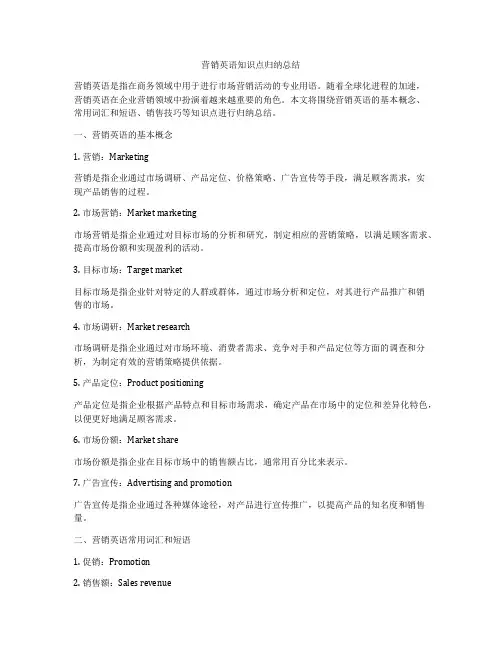
营销英语知识点归纳总结营销英语是指在商务领域中用于进行市场营销活动的专业用语。
随着全球化进程的加速,营销英语在企业营销领域中扮演着越来越重要的角色。
本文将围绕营销英语的基本概念、常用词汇和短语、销售技巧等知识点进行归纳总结。
一、营销英语的基本概念1. 营销:Marketing营销是指企业通过市场调研、产品定位、价格策略、广告宣传等手段,满足顾客需求,实现产品销售的过程。
2. 市场营销:Market marketing市场营销是指企业通过对目标市场的分析和研究,制定相应的营销策略,以满足顾客需求、提高市场份额和实现盈利的活动。
3. 目标市场:Target market目标市场是指企业针对特定的人群或群体,通过市场分析和定位,对其进行产品推广和销售的市场。
4. 市场调研:Market research市场调研是指企业通过对市场环境、消费者需求、竞争对手和产品定位等方面的调查和分析,为制定有效的营销策略提供依据。
5. 产品定位:Product positioning产品定位是指企业根据产品特点和目标市场需求,确定产品在市场中的定位和差异化特色,以便更好地满足顾客需求。
6. 市场份额:Market share市场份额是指企业在目标市场中的销售额占比,通常用百分比来表示。
7. 广告宣传:Advertising and promotion广告宣传是指企业通过各种媒体途径,对产品进行宣传推广,以提高产品的知名度和销售量。
二、营销英语常用词汇和短语1. 促销:Promotion2. 销售额:Sales revenue3. 客户满意度:Customer satisfaction4. 市场份额:Market share5. 成本效益分析:Cost-benefit analysis6. 品牌形象:Brand image7. 目标市场:Target market8. 市场定位:Market positioning9. 定价策略:Pricing strategy10. 市场调研:Market research11. 营销策略:Marketing strategy12. 客户关系管理:Customer relationship management13. 产品推广:Product promotion14. 市场竞争分析:Market competition analysis15. 渠道管理:Channel management16. 供应链管理:Supply chain management17. 市场营销计划:Marketing plan18. 产品包装设计:Product packaging design19. 品牌定位:Brand positioning20. 品牌推广:Brand promotion三、营销英语中的销售技巧1. 善于倾听客户需求:Listen to customer needs营销人员在与客户接触时,要善于倾听客户的需求和意见,了解他们的真实诉求,从而更好地针对其需求进行产品推广和销售。
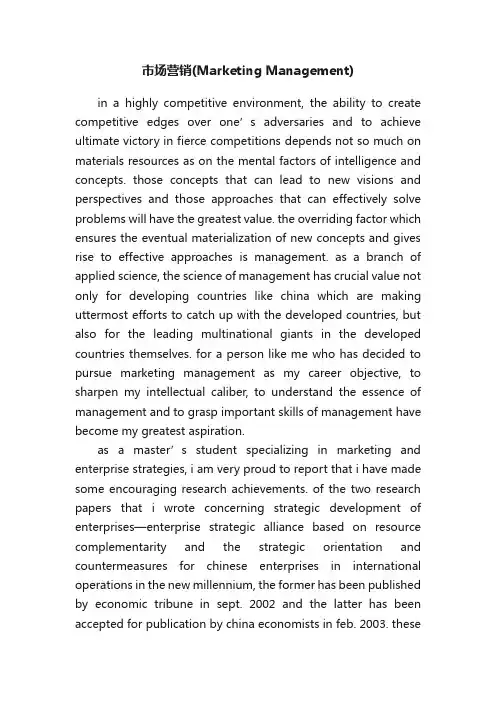
市场营销(Marketing Management)in a highly competitive environment, the ability to create competitive edges over one’s adversaries and to achieve ultimate victory in fierce competitions depends not so much on materials resources as on the mental factors of intelligence and concepts. those concepts that can lead to new visions and perspectives and those approaches that can effectively solve problems will have the greatest value. the overriding factor which ensures the eventual materialization of new concepts and gives rise to effective approaches is management. as a branch of applied science, the science of management has crucial value not only for developing countries like china which are making uttermost efforts to catch up with the developed countries, but also for the leading multinational giants in the developed countries themselves. for a person like me who has decided to pursue marketing management as my career objective, to sharpen my intellectual caliber, to understand the essence of management and to grasp important skills of management have become my greatest aspiration.as a master’s student specializing in marketing and enterprise strategies, i am very proud to report that i have made some encouraging research achievements. of the two research papers that i wrote concerning strategic development of enterprises—enterprise strategic alliance based on resource complementarity and the strategic orientation and countermeasures for chinese enterprises in international operations in the new millennium, the former has been published by economic tribune in sept. 2002 and the latter has been accepted for publication by china economists in feb. 2003. thesetwo research papers are the fruition of my active involvement in a research project named study on chinese enterprises’ cooperation-competition models in hyper-competitive conditions, which is sponsored by china state natural science foundation (foundation project no. 70140132). another paper entitled brand marketing: a competitive mode on a higher level in modern economics has been published by contemporary finance & economics in november this year. those research achievements can unmistakably indicate my tremendous potential to perform much more ambitious researches in my future degree program and i am determined to develop this potential to the fullest extent.i completed my four-year systematic studies in engineering and management science as an undergraduate at the school of economics and management, beijing university of aeronautics and astronautics. it is precisely this undergraduate education that has reinforced my determination to pursue marketing management as my lifelong career. although as an undergraduate my understanding of some courses cannot be described as profound (some might even be said to be rather superficial), my learning of those courses nevertheless widened my ken of knowledge and broadened my vision.。
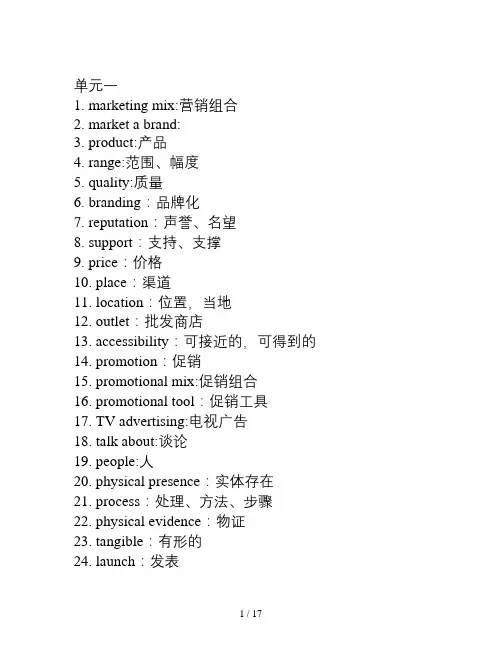
单元一1. marketing mix:营销组合2. market a brand:3. product:产品4. range:范围、幅度5. quality:质量6. branding:品牌化7. reputation:声誉、名望8. support:支持、支撑9. price:价格10. place:渠道11. location:位置,当地12. outlet:批发商店13. accessibility:可接近的,可得到的14. promotion:促销15. promotional mix:促销组合16. promotional tool:促销工具17. TV advertising:电视广告18. talk about:谈论19. people:人20. physical presence:实体存在21. process:处理、方法、步骤22. physical evidence:物证23. tangible:有形的24. launch:发表25. distribution:分布、分配26. delivery:交付(贸易)27. advertising:广告28. direct marketing:直接营销29. customer:顾客30. competitor:竞争者31. premium pricing:保险定价32. special deals:特殊交易单元二1. customer need:顾客需求2. solve a problem:解决问题3. meet these need:满足他们的需求4. cost to user:消费者5. perceive the cost:理解消费、认知消费6. convenience:便利7. convenient:方便的8. make an effort:作出努力9. communication:通讯10. communicate:通讯、传达11. acceptability:可接受性13.acceptable 可接受的14.socially acceptable 可被社会接受的15.fashionable 流行的16.attractive 引人瞩目的17.affordability 可购性18.legally acceptable 法律上可接受的19.accessibility 易接近,可达到20.easy to access 容易得到21.accessible 易接近的22.awareness 认识、意识、明白23.aware of:意识到,知道24.high 高度25.object 目标26.manufacturerd 制造27.high quality 高质量28.bottom end 低档的29.objective 客观的,目标的30.revenue objective 收益目标anizations 组织anize 组织33.distribution method 分配方式34.operations 操作35.promotional operation 促销办法36.attract 吸引37.attention to 对··的注意38.become aware of 使得关心39.create an interest in 创造一个兴趣点40.develop an interest 发展权益41.develop a desire 发展一个愿望42.actively want:积极想要43.prompt action:迅速采取行动44.take steps 步骤第三单元1. Carry out 实施2. SWOT analysis:SWOT分析3. Identifies:识别、确定4. Strength:优势5. Weakness:劣势6. Opportunity:机会7. Threat:威胁8. Internal factor:内部9. External factor:外部10. Exploit:开发11. Build on strength:建立优势12. Anticipate the threat:预料威胁13. Seize the new opportunity:抓住机会14. Address:处理15. Pose a serious threat:提出很大威胁16. Minimize the weaknesses: 最小化劣势17. Under threat from:来自于。
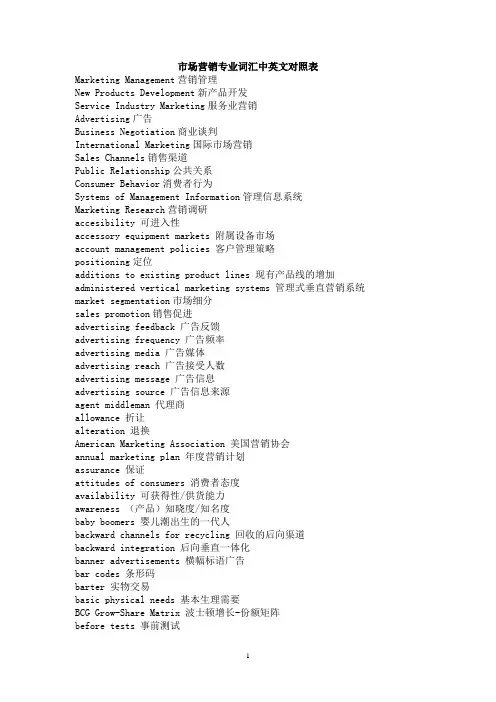
市场营销专业词汇中英文对照表Marketing Management营销管理New Products Development新产品开发Service Industry Marketing服务业营销Advertising广告Business Negotiation商业谈判International Marketing国际市场营销Sales Channels销售渠道Public Relationship公共关系Consumer Behavior消费者行为Systems of Management Information管理信息系统Marketing Research营销调研accesibility 可进入性accessory equipment markets 附属设备市场account management policies 客户管理策略positioning定位additions to existing product lines 现有产品线的增加administered vertical marketing systems 管理式垂直营销系统market segmentation市场细分sales promotion销售促进advertising feedback 广告反馈advertising frequency 广告频率advertising media 广告媒体advertising reach 广告接受人数advertising message 广告信息advertising source 广告信息来源agent middleman 代理商allowance 折让alteration 退换American Marketing Association 美国营销协会annual marketing plan 年度营销计划assurance 保证attitudes of consumers 消费者态度availability 可获得性/供货能力awareness (产品)知晓度/知名度baby boomers 婴儿潮出生的一代人backward channels for recycling 回收的后向渠道backward integration 后向垂直一体化banner advertisements 横幅标语广告bar codes 条形码barter 实物交易basic physical needs 基本生理需要BCG Grow-Share Matrix 波士顿增长-份额矩阵before tests 事前测试Behavior Scan Information Resources Inc. 行为扫描信息源公司behavioural analysis 行为分析behavioural hierarchies 行为层级benchmarking 基准benefit clusters 利益群体benefits 利益Benz 奔驰billing 帐单birth rate 出生率blanket purchase order 一揽子采购合同blind-paired comparison testing 双盲比较测试blue collars 蓝领bottom line 底线/盈亏一览结算线brand awareness 品牌意识/认知brand extensions 品牌扩展brand loyalty 品牌忠诚度brand mark 品牌标志brand name 品牌名称brand positioning 品牌定位brand recognition 品牌识别brand strategies 品牌战略brand 品牌branding strategy 品牌化战略branding 品牌化brand's equity 品牌的价值break-even analysis 盈亏平衡分析break-even volume 盈亏平衡产量breath of product assortment 产品线的宽度breath or diversity of product lines 产品线的宽度或多样性bribery 贿赂British Airways 英国航空公司brokers 经纪人budgeting 预算bundle 捆绑Bureau of Census 人口统计局busines strength rating 商业能力评分business plan 商业计划business position 经营地位business sector 商业部门business services markets 商业服务市场business strategies 经营战略business unit strategy 经营单位战略buyback allowances 回购折让buyback arrangements 产品返销buyers' bargaining power 买方的讨价还价能力buyers 采购者buying behavior 购买行为buying center 采购中心buying inertia 购买惯性buying intention 购买意图buying offices 连锁商店的进货中心buying power indes (BPI) 购买力指数buying situation 采购情况/类型buying task 采购任务capital gains 资本收益capital invested in product 产品投入资本Carnival 嘉年华cash cows 现金牛类cash discounts 现金折扣catalogue sales 目录销售categorization of perception 感知分类categorization 分门别类centralization 集中化chameleons/followers 变色龙/跟随者channel alternatives 可选择的营销渠道channel conflicts 渠道冲突channel decisions 渠道决策channel functions 渠道功能channel institutions 渠道组织结构channel management 渠道管理channel objectives 渠道目标channel of distribution 分销渠道channel power 渠道权力channel-control strategies 渠道控制战略channel-design decisions 渠道设计决策channel-management decisions 渠道管理决策channels of communication 传播渠道choice criteria 选择标准closing a sale 结束销售clothing retailers 服装零售商co-branding 联合品牌code of ethics (职业)道德标准coercive power 强制权cognitive dissonance 认识的不协调collection of data 数据收集collection 收款co-marketing alliances 联合营销联盟combination compensation plan 结合式薪酬方案commitment 承诺communication channels 传播渠道communication process 传播过程communication 信息交流/沟通communications media 传播媒体company personnel 公司员工comparative advertisements 比较广告comparison of brands 品牌比较compensation deals 补偿处理compensation plan 酬金方案compensation/rewards 酬金/奖励compensatory 补偿性的competition and industry evolution 竞争和行业演变competition-orientated pricing 竞争导向定价法competitive advantage 竞争优势competitive (supply-side) evolution 竞争(供方)演变competitive factors 竞争因素competitive intelligence 竞争情报/信息competitive parity promotion budgeting 竞争均势促销预算法competitive strategy 竞争战略competitive strength 竞争优势/能力competitor analysis 竞争者分析complaint handling 投诉处理component materials and parts markets 组成材料和零部件市场computerized ordering 计算机化的订购conclusive research 确定性研究conditions of demand 需求情况conflict and resolution strategies 冲突和解决战略conformance to specifications 与规格一致conformance 一致性confrontation strategy 对抗战略conjoint measurement 联合测度法conjunctive model 联合模型consumer decision-making 消费者(购买)决策consumer goods channels 消费品分销渠道Consumer Goods Pricing Act, USA 美国消费品定价法案consumer goods 消费品consumer markets 消费品市场consumer needs 消费者需求consumer packaged-goods firms 消费者包装食品公司consumer promotion 消费者促销consumer tests 消费者测试consumer/household market 消费者/家庭市场consumers' perceptions 消费者感知consumption 消费contests 竞赛contingency planning 权变计划contract construction 契约建筑业contract manufacturing 契约制造业contraction/strategic withdrawal strategy 收缩/战略性撤退战略contractual entry modes 契约式进入模式contractual vertical marketing systems 合约式垂直营销系统contribution margin analysis 边际贡献(贡献毛利)分析contributrion margin 边际贡献control strategies 控制战略convenience food stores 便利食品商店convenience goods 便利品convenience 服务的便利性Cool Whip 清凉维普co-operative advertising 合作性广告co-ordination and conflict resolution 协调与冲突解决co-production 合作生产core benefit proposition (CBP) 核心利益方案/提议corollary-data method 推定数据法corporate HQ 公司总部corporate scope 公司(经营)范围corporate strategy 公司战略corporate vertical marketing systems 公司式垂直营销系统corporate/institutional advertising 团体/社会公共机构广告corrective action 矫正行动cost analysis 成本分析cost effectiveness 成本有效性cost leadership strategy 成本领先战略cost of capital 资本成本cost of goods sold (COGS) 产品销售成本cost reductions 降低成本产品cost-and-volume relationship 成本-数量关系cost-oriented pricing 成本导向定价法cost-plus/mark-up pricing 成本加成/溢价定价法costs and benefits of marketing functions 营销职能的成本和效益costs of competitors 竞争者成本costs of distribution 分销成本countertrade 对等贸易coupons 优惠券courtesy 礼貌coverage of geographic market 地域性市场的范围coverage of relevant retailers 相关零售商的销售范围credibility 信誉credit terms 信贷条款critical assumptions 关键假设cross-elasticity 交叉弹性customary pricing 习惯性定价法customer analysis 顾客分析customer contact 顾客接触customer demand 顾客需求customer intimacy 顾客亲密度customer loyalty 顾客忠诚度customer need 顾客需要customer organization of sales force 按客户组织销售队伍customer retention 顾客维系/保留customer satisfaction 顾客满意度customer segment pricing 顾客细分市场定价customer service 顾客服务customer-oriented pricing 顾客导向定价法customers' perception 顾客感知customers' preferences 顾客偏好customers' price sensitivity 顾客的价格敏感度customizing 定制data collection 数据收集data confidentiality 数据保密data research 数据研究data sources 数据来源dealers 经销商deceptive advertisements 欺骗性广告deciders 决策者declining markets 衰退市场decoding 解码defect rate 缺陷率defender strategy 防御型战略defensive new-product development strategy 防御性新产品开发战略defensive positioning 防御性定位delivery time 交付时间delivery 配送demand characteristics 需求特征demand curve 需求曲线demand-oriented pricing 需求导向定价法demographic environment 人口统计环境department stores 百货商店dependability 可靠性deregulation 放松管制derived demand 衍生需求descriptive research 描述性研究design decisions 设计决策desired percentage mark-up on retail 预期零售利润率desired percentage return 预期回报率determinant attributes 关键属性determinants 决定因素different responses 差别反应differentiated defender strategy 差异化防御战略differentiated marketing 差异化营销differentiation over time 不同时间的差异differentiation strategy 差异化战略differentiation 差异化diffusion of innovation theory 创新扩散理论dimension 因素dimensions of quality 质量维度direct costing profitability analysis 直接成本盈利性分析direct mail 直接邮寄direct marketing via advertising media 通过广告媒体的直接营销direct marketing 直接营销direct product profitability (DPP) 直接产品盈利性/利润率direct selling 直销discount rate 贴现率discount stores 折扣商店discount 折扣discount/premium price policies 折扣/溢价策略discriminant analysis 差异分析法discriminatory adjustments 歧视价格调整discriminatory pricing adjustments 歧视定价调整disjunctive model 分离模型display space 陈列空间disposable income 可支配收入dissonance-attribution hierarchy 不和谐-归属层次结构distribution channel designs 分销渠道设计distribution channel objectives 分销渠道的目标distribution channel 分销渠道distribution decisions 分销决策distribution policies 分销策略distribution 分销distributor/store (private lables) brands 分销商/私有品牌distributors 分销商diversification 多元化divest 撤退divest 出让divestment or liquidation 收回投资或清算dividend 红利dogs 瘦狗类domestic target marketing strategies 国内目标市场定位的营销战略dropping products 放弃产品dry cleaning 干洗dual/two channel distribution systems 双重分销系统duplication (媒体)重复DuPont 杜邦公司durability 耐用性early vs late adoption 早期采购与后期采购earnings per share 每股收益economic and technological factors 经济技术因素economic power 经济权economies of scale 规模经济education services 教育服务effectiveness 有效性efficiency 效率emergency goods 急需品emotional appeals 情感诉求empathy 移情作用empirical evidence 经验性实例empowerment 授权encoding 编码end use 最终使用endorsement 赞同engineering (产品)工程设计entrepreneurial strategy 企业家战略entry strategies 进入战略environment and packaging disposal 环境与包装处理environment factors 环境因素environmental scanning 环境扫描/分析environmental strategy 环境战略establishment 机构ethical audit (公司)伦理审计ethics of marketing 营销伦理道德ethnic composition 种族构成European Community 欧共体evaluation and reward systems 评估与奖励体系evaluation and selection of supplier 评估和选择供应商evaluation of alternatives 评估替代品/各种选择evaluation of brands 品牌评估event sponsorship 事件赞助event 活动everyday low-price (EDLP) 天天低价evoked set 引发的组合evolution of market 市场演变exchange 交换exclusive dealing 独家销售exclusive distribution 独家分销executive summary 执行摘要exhibition media 展示广告媒体existing market 现有市场exit barriers 退出壁垒expansion path 扩张途径expectation measures (顾客)预期测度expectations of customers 顾客期望expected unit sales 预计产量expected value 期望价值experience curve 经验曲线experimental research 实验性研究expert power 专长权exploratory research 探索性研究export agents 出口代理(商)export jobbers 出口批发商export management company 出口管理公司export merchants 出口贸易商export 出口exporting 出口商品extended use strategy 扩大使用战略extending volume growth 扩大市场份额external data sources 外部数据来源external environment 外部环境extrapolation of past sales trends 过去销售趋势推测法facilitating agencies 辅助/中介机构factor analysis 因素分析法fads 时尚family branding 家族品牌family life cycle 家庭生命周期family structure 家庭结构farm products 农产品fast-moving consumer goods (FMCG) 快速变动的消费品fear appeals 恐惧/顾虑诉求features 特征Federal Department Stores 联邦百货商店Federal Trade Code (FTC) 联邦贸易法案FedEx (Federal Express) 联邦快递feedback data 反馈数据field test marketing 实地市场测试financing 融资fisheries 渔业fit and finish 结实度与外观fixed costs 固定成本fixed salary 固定工资flanker strategy 侧翼进攻战略flanker/fighting brand 战斗品牌flanking and encirclement strategies 侧翼进攻与围堵战略flat organizational structure 扁平的组织结构FOB origin pricing FOB产地定价法focus strategy 集中战略followers 追随者Ford 福特公司foreign middlemen 国外中间商forestry 林业formalization 形式/规范化formulate 制定fortress/position-defence strategy 防御堡垒战略Fortune 《财富》杂志forward integration 向前一体化franchise systems 特许系统franchising 特许经营free call numbers 免费电话号码free goods 免费商品freight-absorption pricing 免收运费定价法fringe benefits 小额津贴frontal attack strategy 正面进攻战略full costing profitability analysis 全成本盈利性分析full-service wholesalers 全方位服务的批发商functional competencies and resource allocation 职能能力与资源分配functional efficiency 职能效率functional organization of sales force 按销售职能组织销售队伍functional organizational structure 职能型组织结构functional performance 功能性能functional strategy 职能战略games 比赛gap 差距gatekeepers 信息传递者general behavioral descriptors 一般行为变量General Electric (GE) 通用电气General Foods Corporation 通用食品general merchandise discount chains 大众商品折扣连锁店General Motors 通用汽车geodemographics 区域人口统计特征geographic adjustments 地理调整geographic distribution 地理分布geographical organization of sales force 按地区组织销售队伍Gillette 吉列剔须刀global adjustments 全球调整global elite consumer segment 全球精英消费品市场global expansion 全球扩张global marketing control 全球营销控制global markets 全球市场global niche strategy 全球机会战略global standardization strategy 全球标准化战略global teenage segment 全球青少年市场globalization 全球化global-market expansion 全球市场扩张goals 总目标going-rate/competitive parity pricing 竞争性平价定价法goods producers 产品制造商Goodyear 固特异轮胎government agencies 政府机构government buyers 政府采购者government market 政府市场government regulation 政府管制greenhouse effect 温室效应grey market 灰色市场gross domestic product (GDP) 国内生产总值gross margin 毛利gross national product (GNP) 国民生产总值gross profit 毛利gross rating points (GRPs) 总级别指数group/category product manager 类别产品经理growing markets 成长市场growth rate of market 市场增长率growth stage of product life cycle 产品生命周期的成长阶段growth-extension strategies 增长扩张战略growth-market strategies for market leaders 市场领导者的市场增长战略growth-market strategy 成长性市场战略growth-market targeting strategy 成长性市场定位战略guarantee/warranty 保证/担保guarantees 保证Gucci 古琦(世界著名时装品牌)Haagen-Dazs 哈根达斯hard technology 硬技术Harvard Business Review 《哈佛商业评论》harvest 收获harvesting pricing 收获定价法harvesting strategy 收获战略health care 医疗保健health maintenance organizations (HMOs) (美国)卫生保健组织heavy buyer 大客户Heileman Brewing CompanyHeinz 亨氏食品helpfulness 有益性Henkel 汉高Hertz 赫兹(美国汽车租赁巨头)Hewlett-Packard 惠普公司hierarchy of strategy 战略的层次high margin/low-turnover retailers 高利润/低周转率的零售商high market share global strategy 高市场份额全球战略high-contact service system 高接触服务系统high-involvement product 高参与产品high-involvement purchase 高参与购买hight market share 高市场份额战略Hilton 希尔顿Holiday Inns 假日旅馆homogeneous market 同质市场Honda 本田household/family life cycle 家庭生命周期household 家庭hybrid technology 混合技术idea generation 创意的产生/生成ideas for new products 新产品创意/构想idea-screening process 创意筛选过程identification of segments 识别细分市场Illinois Tool Works 伊利诺斯工具厂image pricing 形象定价imitative positioning 模仿定位imitative strategy 模仿战略impact evaluation 影响评估impersonal sources 非个人的信息来源implementation and control of marketing programs 营销计划的执行和控制implementation 实施improvements in or revisions of existing products 现有产品的改良或修正impulse buying 冲动购买impulse goods 冲动购买品incentives 激励income 收入increased penetration strategy 增加渗透战略indirect costing profitability analysis 间接成本盈利性分析individual brand 个别品牌individual value 个人价值industrial goods & services 工业产品和服务industrial goods channels 工业品分销渠道industry attractiveness 行业吸引力industry attractiveness-business position matrix 行业吸引力-业务地位矩阵industry dynamics 产业动态industry evaluation 产业评估industry evolution 产业演变inelastic 缺乏价格弹性influencers 影响者infocommunications industry 信息通信行业infomercials 商业信息广告information age 信息时代information search 信息搜集information technology 信息技术information 信息informative 告知性的ingredient 成份in-home personal interview 个人家庭访谈in-house use tests 内部使用测试innovation 创新innovativeness 创新性installation 设施in-store display 店内展示in-store positioning 店内布局in-store promotion 店内促销intangibles 无形integrated marketing communication plan (IMC) 整合营销传播计划integration of perception 感知整合integration 整合Intel 因特尔intensity of market position 市场地位的集中程度intensity 集中程度intensive distribution 密集型分销interactions across multiple target markets 多目标市场间的相互作用interactive media 交互式媒体interest rates 利率internal data sources 内部数据来源internal marketing 内部营销internal organizational structure 内部组织结构international advertising 国际广告international channels 国际分销渠道international division 国际分部international marketing 国际营销international organizational design 国际组织设计internationalization of services 服务的国际化introductory stage of product life cycle 产品生命周期的推出阶段inventory level 库存水平investor relations advertising 投资关系广告issue advertising 观点广告jobbers 批发商Johnson & Johnson 强生joint ventures 合资jury of executive opinion 行政管理人员群体意见法just noticeable difference (JND) 恰巧注意到的差异just-in-time (JIT) management system 准时制管理体系just-in-time purchasing arrangements 及key account management 主要客户管理key accounts 关键客户key benefits 核心利益key environmental issue identification 确定主要的环境问题key variables 关键变量key/house accounts 关键/机构客户laboratory tests 实验室测试leapfrog strategy 蛙跳战略learning hierarchy 学习层级结构legal services 法律服务legislation 立法legitimate power 法定权level of compensation 酬金水平level of technical sophistication 技术的复杂程度Levi Strauss 李维·史特劳斯Levi's 列维斯(全球最大的牛仔服制造商)lexicographic model 词典编纂模型lifestyle 生活方式limited-service wholesalers 有限服务的批发商line extension 产品线扩展line filling 产品线填充line stretching 产品线延伸list price 订价Lloyd's of London 伦敦劳埃德保险公司localizaiton strategy 本地化战略location pricing 场所定价location 位置lodging 房屋出租logistical alliances 后勤联盟long-term memory 长期记忆lost customer 失去的顾客Louis Vuitton 路易·威登(法国著名时尚品牌)low-contact service system 低接触服务系统low-cost defender 低成本防御型low-cost position 低成本地位low-involvement hierarchy 低参与程度层级结构macro risks 宏观风险macroenvironment 宏观环境macrosegmentation 宏观细分mail-order retailers 邮购零售商maintaining market share 保持市场份额maintenance strategy 保持战略management overhead 管理费mandatory adaptation 强制性适应manufacturer brand 制造商/全国性品牌manufacturers' agents/representatives 生产商的代理商/销售代表manufacturers' export agents (MEA) 制造商出口代理manufacturers' sales offices/branches 生产商的销售办事处/分支机构manufacturing process 制造过程manufacturing 制造业market aggregation strategy 整体市场战略market attractiveness factors 市场吸引力因素market attractiveness 市场吸引力market attractiveness/business position matrix 市场吸引力/业务地位矩阵market circumstances 市场环境market demorgraphics 市场人口分布/统计特征market dimension 市场量度market entry strategies 市场进入战略market exclusion 市场排斥market expansion strategy 市场扩张战略market factors 市场因素market followers 市场跟随者market growth rate 市场增长率market hirarchy 市场等级market inclusion 市场纳入market leaders 市场领导者market measurement 市场测量market opportunity analysis 市场机会分析market oriented 以市场为导向的market position factors 市场地位因素market positioning analysis 市场定位分析market potential measurements 市场潜力测度market research 市场研究market segment 细分市场market segmentation 市场细分market share 市场份额market targeting 目标市场选择market 市场marketability 市场开拓能力market-entry strategies 市场进入战略marketing action plan 营销行动计划marketing audit 营销审计marketing channel 营销渠道marketing codes of conduct 营销行为规范marketing communication 营销沟通/传播marketing concept 营销观念marketing control 营销控制marketing decision support systems (MDSS) 营销决策支持系统marketing environment audit 营销环境审计marketing flows and functions 营销过程和职能marketing function area audit 营销功能领域的审计marketing implications of 对营销的影响marketing information system 营销信息系统marketing institutions 营销机构marketing management 营销管理marketing message 营销信息marketing mix 营销组合marketing policy 营销策略marketing productivity area audit 营销生产力领域的审计marketing program components 营销计划内容marketing program 营销计划/方案marketing relationship 营销关系marketing research 营销研究marketing strategy 营销战略market-management organizational structure 市场管理组织结构mark-up price 产品/溢价价格Marlboro 万宝路Marriott Hotel 万豪酒店mass-market penetration strategy 大规模市场渗透战略mass-market strategy 大市场战略matrix organizational structure 矩阵组织结构Matsushita 日本松下电子mature conformists 成熟的随大流者mature markets 成熟市场mature stage of product life cycle 产品生命周期的成熟阶段McDonald's 麦当劳McDonnell Douglas 麦道公司MCI电讯公司(前世界通信公司)MDSS (Marketing-Decision Support System) 市场决策支持系统measurability 可测度性measure or index 测量指标measurement criteria 计量标准media audiences 媒体受众medical and health services 医疗卫生服务Medico Containment Servicesmemory of consumers 消费者记忆Mercedes-Benz 梅赛德斯-奔驰Mercer Management Consulting 美国美智管理顾问公司merchandising 推销merchant middlemen 国内贸易中间商merchant wholesalers 商业批发商message structure 信息结构Michael Porter 迈克尔-波特micro risks 微观风险microsegmentatioin 微观细分Miller Tyding ACT, USA 米勒·泰丁法案minging 矿业Minnesota Mining and Manufacturing Company (3M) 明尼苏达矿业和制造公司Minolta 美能达miscellaneous sources 多方面来源mission 宗旨missionary selling 推销式销售Mitsubishi Heavy Industries 三菱重工modified rebuy 调整再购monosegment positioning 单一细分市场定位Monsanto 孟山都农业生物技术公司moral appeals 伦理/道德诉求morals 道德Motorola 摩托罗拉multichannel distribution 多渠道分销multidimensional scaling 多维等级法multilevel selling 多级销售multinational coporations (MNCs) 跨国公司multiple test markets 多测试市场multiple-brand strategy 多品牌战略multiple-factor index 多因素指数法multisegment positioning 多重细分市场定位mutual trust 相互信任national account management 全国性客户管理national market 国内市场National Semiconductor 美国国家半导体公司natural products 天然产品NEC 日本电子Nescafé 雀巢咖啡Nestlé 雀巢net sales 净销售额network computer (NC) 网络计算机new business selling 新业务销售new buy 购入新产品new entrants 新进入者new markets 新市场new materials 新材料New Prod screening model 新普罗德筛选模型new product lines 新产品线new products 新产品new-product development 新产品开发new-product ideas 新产品创意Newsweek 《新闻周刊》new-task buying 全新采购new-to-the-world products 世界性新产品niche penetration strategy 壁龛/机会市场渗透战略niche-market strategy 壁龛市场战略Nike 耐克Nissan 尼桑no-brand brand name 无品牌的品牌名称no-frills product 无虚饰产品noise in communication system 传播系统中的噪音non-financial rewards 非物质性奖励措施non-probability sampling 非概率抽样non-profit organization 非盈利组织non-store retailing 无店铺零售业number of stockouts 迟滞数目object-and-task method of promotion budgeting 目标-任务促销预算法objectives and strategy area audit 目标与战略领域的审计objectives 具体目标observation 观察法occupancy costs 房屋占用成本occupation/position 职业/职位odd pricing 奇/余数定价法OEM (original equipment manufacturer) 原始设备制造商oeverall quality 总体质量off-invoice discounts 发票之外的折扣offsets 抵消交易Omega 欧米加on-air testing 广播测试OPEC (Organization of Petroleum Exporting Countries) 欧佩克(石油输出国组织)opening relationships 建立关系operating supplies 生产供应品operational excellence 运作管理水平opinion leaders 意见领导者opportunity cost 机会成本opportunity identification 机会识别opportunity/threat matrix 机会/威胁矩阵order cycle time 订货周期order processing 订单处理organisational level 组织层次organizaitonal requirement planning 组织需求计划organization area audit 组织领域的审计organization buying center 组织采购中心organizational customer 组织顾客organizational direct selling 组织直销organizational markets 组织市场organizational purchasing 组织采购organzational structure 组织结构outdoor enthusiasts 户外运动爱好者out-of-home media 户外广告媒体overall cost leadership 全面成本领先overheads 日常开支overseas direct investment 海外直接投资ownership of new product 新产品所有权packaging 包装panel of experts 专家小组parentage 渊源parties involved 交换中的各方payment terms 支付条款pay-off control 支出控制penetration pricing 渗透定价Pepsi-Cola 百事可乐perceived customer value 顾客感知价值perceived quality 感知到的质量perceived value 感知到的价值percentage of sales promotion budgeting method 销售额百分比促销预算法perceptions of consumers 消费者感知/理解perceptual (product) pisitioning 感知(产品)定位perceptual map 感知图perceptual organization 感知组织perceptual vigilance 感性的警惕performance dimension 业绩标准performance evaluation 业绩评估performance measures 表现/业绩测度performance objective 绩效目标performance standards 绩效标准performance 功能perishability 非持久性personal selling 人员推销personal sources 个人的信息来源personnel development 人力资源开发persuasive 说服性的pharmaceuticals industry 医药行业physical (product) positioning 物理(产品)定位physical descriptors 物理变量physical distribution 实物分销Pillsbury 皮尔斯博瑞pioneers 先入者Pizza Hut 必胜客place utility 地点效用planning and control system area audit 计划与控制系统领域的审计point of sale information 销售点信息point-of-purhcase (POP) promotion 采购点促销point-of-sales (POS) data 销售点数据pontificator 保守派popularity 通用性population trends 人口趋势portfolio models for resource allocation 资源配置的资产组合模式position intensity 地位集中程度positioning 定位possession utility 拥有效用post-purchase dissonance 购买后的不协调post-purchase evaluation 购买后评估post-purchase/after-sale service 售后服务potential advantages 潜在优势potential customer 潜在顾客potential market 潜在市场potential target market 潜在目标市场power in distribution 分销权力power of buyers 购买者能力power of suppliers 供应商能力predatory pricing 掠夺性定价法pre-empting scarce resources 先占稀缺资源preferential treatment 特惠待遇premiums 额外奖励present competitors 现有的竞争者presenting sales message 提供销售信息pre-test market research 测试前市场研究price discrimination 价格歧视price elasticity of demand 需求的价格弹性price fixing 价格设定price leaders 价格领导者price lining 价格排列定价法price promotion 价格促销price quotation 报价price sensitivity 价格敏感度price structure 价格结构price 价格price/earnings ration 价格/收益比price-off promotions 降价促销price-setting process 定价过程pricing adjustments 定价调整pricing policies 价格策略pricing 定价primary demand 基本需求primary sources 第一类/主要数据print media 印刷媒体private/for-profit organization 私营/盈利性组织PRIZM (Potential Rating Index for Zip Markets) 按邮政区划为基础的潜力等级指数proactive new-product development strategy 进取型新产品开发战略probability sampling 概率抽样problem formulation 界定问题problem identificatioin 确定问题process management 过程管理Procter & Gamble (P&G) 宝洁公司product line 产品线product availability 产品的可获得性product category 产品类别product class 产品类别product decisions 产品决策product design 产品设计product development 产品开发product dimension or attributes 产品维度/属性product evolution 产品演变product features 产品特征product intent share 产品倾向份额product leadership 产品领导能力product life cycle (PLC) 产品生命周期product life cycle curve 产品生命周期曲线product line 产品线product manager audit 产品经理审计product offering 供应品product organizaiton of salesforce 按产品组织销售队伍product policies 产品策略product positioning 产品定位product quality 产品质量product scope 产品范围product space 产品位置product specifications 产品规格product systems 产品体系product type 产品类型product usage 产品用途product 产品product(ion)-oriented organization 产品/生产导向型组织production 生产product-line pricing adjustments 产品线定价调整product-management organizational structure 产品管理组织结构product-market entry control 产品-市场进入控制product-related behavioral descriptors 与产品相关的行为变量product's market characteristics 产品的市场特征product-use testing 产品使用测试pro-environment 环保profit impact of market strategy (PIMS) 市场战略的利润影响profitability analysis 盈利性分析profitability 盈利性/盈利能力profitable survivor strategy 有利可图的生存者战略project-company resource compatibility 项目与公司资源的协调性projected profit-and-loss statement 预计损益表projective tests 投影测试promotion decisions 促销决策promotion mix 促销组合promotion policies 促销策略promotion 促销promotional allowance 促销折让promotional effort 促销努力promotional pricing 促销定价promptness 及时性propector strategy 探索型战略prospecting for customers 寻找顾客。
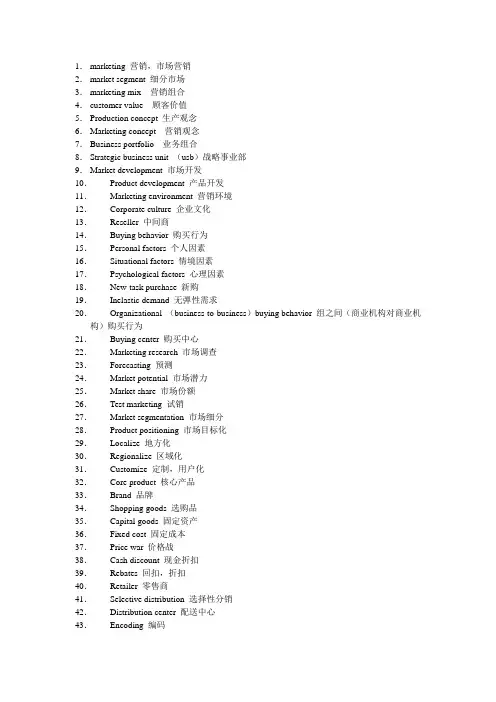
1.marketing 营销,市场营销2.market segment 细分市场3.marketing mix 营销组合4.customer value 顾客价值5.Production concept 生产观念6.Marketing concept 营销观念7.Business portfolio 业务组合8.Strategic business unit (usb)战略事业部9.Market development 市场开发10.Product development 产品开发11.Marketing environment 营销环境12.Corporate culture 企业文化13.Reseller 中间商14.Buying behavior 购买行为15.Personal factors 个人因素16.Situational factors 情境因素17.Psychological factors 心理因素18.New-task purchase 新购19.Inelastic demand 无弹性需求20.Organizational (business-to-business)buying behavior 组之间(商业机构对商业机构)购买行为21.Buying center 购买中心22.Marketing research 市场调查23.Forecasting 预测24.Market potential 市场潜力25.Market share 市场份额26.Test marketing 试销27.Market segmentation 市场细分28.Product positioning 市场目标化29.Localize 地方化30.Regionalize 区域化31.Customize 定制,用户化32.Core product 核心产品33.Brand 品牌34.Shopping goods 选购品35.Capital goods 固定资产36.Fixed cost 固定成本37.Price war 价格战38.Cash discount 现金折扣39.Rebates 回扣,折扣40.Retailer 零售商41.Selective distribution 选择性分销42.Distribution center 配送中心43.Encoding 编码44.Pubic relation 公共关系45.Personal selling 人员推销46.Competitive advantage 竞争优势47.Marketing planning促销计划48.Marketing is the process of the planning and executing the conception,pricing,and distribution of ideas,goods,and services to create exchanges that satisfy individual and organizational objectives。
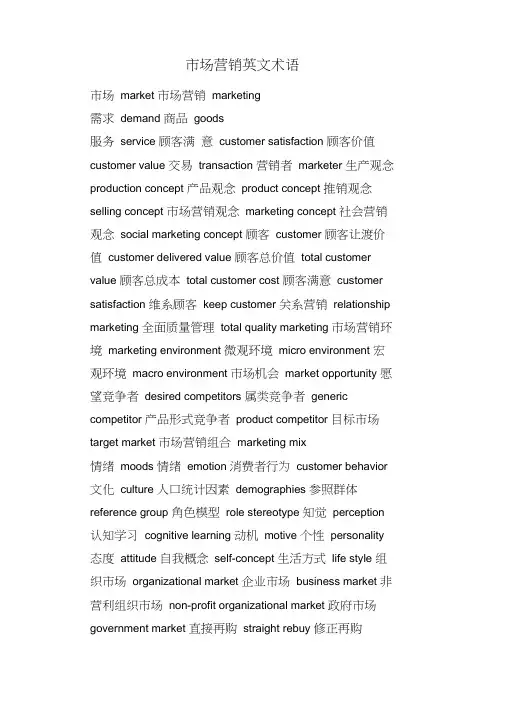
市场营销英文术语市场market 市场营销marketing需求demand 商品goods服务service 顾客满意customer satisfaction 顾客价值customer value 交易transaction 营销者marketer 生产观念production concept 产品观念product concept 推销观念selling concept 市场营销观念marketing concept 社会营销观念social marketing concept 顾客customer 顾客让渡价值customer delivered value 顾客总价值total customer value 顾客总成本total customer cost 顾客满意customer satisfaction 维系顾客keep customer 关系营销relationship marketing 全面质量管理total quality marketing 市场营销环境marketing environment 微观环境micro environment 宏观环境macro environment 市场机会market opportunity 愿望竞争者desired competitors 属类竞争者generic competitor 产品形式竞争者product competitor 目标市场target market 市场营销组合marketing mix情绪moods 情绪emotion 消费者行为customer behavior 文化culture 人口统计因素demographies 参照群体reference group 角色模型role stereotype 知觉perception 认知学习cognitive learning 动机motive 个性personality 态度attitude 自我概念self-concept 生活方式life style 组织市场organizational market 企业市场business market 非营利组织市场non-profit organizational market 政府市场government market 直接再购straight rebuy 修正再购modified rebuy 新任务采购new task 购买中心buying center 倡议者initiators 使用者users 影响者influencers 决定者deciders 购买者buyers 控制者gatekeepers 营销信息marketing information 营销信息系统marketing information system MIS 市场调研market research 描述性调研predictive research 解释性调研interpretive research 市场需求market demand 市场需求潜量market demand potential 企业需求量enterprise demand 企业需求潜量enterprise demand potential定性预测qualitative forecasting 定量预测quantitative forecasting 企业战略enterprise strategy 企业使命说明书enterprise statement 战略经营单位strategy business units,SBU 波士顿矩阵Boston matrix 通用电器公司方法the General Electric Model,GE 市场吸引力market attractiveness 业务实力business attractiveness 密集型增长战略intensive growth strategies 市场渗透market penetration strategy 市场开发market development strategy 产品开发product development strategy 一体化增长战略integrative growth strategies 前向一体化forward integration 后向一体化backwards integration 水平一体化horizontal integration 多角化增长战略diversification growth strategies 同心多角化concentric diversification 水平多角化horizontal diversification 复合多角化conglomeration diversification 市场营销战略marketing strategy 市场营销组合marketing mix 市场营销组织marketing organization 职能型组织functional organization地区型组织regional organization 产品管理型组织managerial organization of product 市场管理型组织managerial organization of market 公司与事业部型组织organization of corporation and business unit市场营销管理marketing management 市场营销计划marketing planning 市场营销方案marketing program 市场营销控制marketing controlling 市场竞争market competition 完全竞争pure competition 非完全竞争imprecate competition 垄断竞争monopolistic competition 市场领导者market leader 市场挑战者market challenger 市场追随者market follower 市场补缺者marketing niche 市场细分market segmentation 目标市场target market 市场定位market positioning 无差异性市场策略undifferentiated marketing tactics 差异性市场策略differentiated marketing tactics 集中性市场策略concentrated marketing tactics 产品product 服务service 核心产品core product 形式产品actual product 期望产品expected product 延伸产品augmented product 潜在产品potential product 耐用品durable goods 非耐用品nondurable goods 产品线product line 产品项目product item 产品组合product mix 产品组合长度product mix length 产品组合宽度product mix width产品组合深度product mix depth 产品组合关联度product mix consistency 产品生命周期product life cycle 开发期development stage 引进期introduction stage 成熟期maturity stage 衰退期decline stage 新产品开发new product development 产品概念product concept 商业化commercialization 包装package 包装策略package strategy 品牌brand 品牌命名brand naming 品牌决策branding decision 统一品牌blanket family brand 品牌使用者决策brand-sponsor decision 个别品牌individual brand 分类品牌separate family brand 多品牌multi-brand 统一的个别品牌company/individual brand 合作品牌co-branding 品牌设计brand designing 品牌资产brand equity 品牌延伸brand extension 内涵不变式延伸invariable meaning extension 内涵渐变式延伸gradual changing meaning extension品牌管理brand management 竞争导向定价competition-driven pricing 折扣定价discount pricing 地区定价region pricing 差别定价discrimination pricing 撇脂定价skim pricing 渗透定价penetration pricing 满意定价neutral pricing 尾数定价mantissa pricing整数定价integer pricing 招徕定价fetch-in pricing声望定价prestige pricing 目标收益定价法target-return pricing 认知价值定价法perceived-value pricing 价值定价法value pricing 通行价格定价法going-rate pricing 分销渠道distribution channel 中间商intermediate 分销渠道设计distribution channel design 实体分配physical distribution 渠道冲突channel conflict cha15 促销策略促销promotion 促销策略promotion policies 理性诉求rational appeals 情感诉求emotional appeals 道德诉求moral appeals 大众传播媒体mass media 气氛atmosphere 事件event 量力支出法affordable method 销售额百分比法percentage-of-sales method 竞争对等法competitive-parity method目标任务法objective-task method 广告advertising 人员推销personal selling公共关系public relations 营业推广sales promotion 促销组合promotion mix推动策略push strategy 拉引策略pull strategy 广告目标mission 告知性广告information advertising 劝告性广告persuasive advertising 提示性广告reminder advertising 整合营销传播integrated marketing communication 服务service 服务核心产品core product 服务附加产品supplement product 服务的无形性intangibility of service 服务体验属性experience attributes 服务的信任度属性credence attributes 服务的有形展示physical evidence 关系营销relationship marketing 体育营销sports marketing 网络营销network marketing 会展营销exhibition marketing 文化营销cultural marketing。
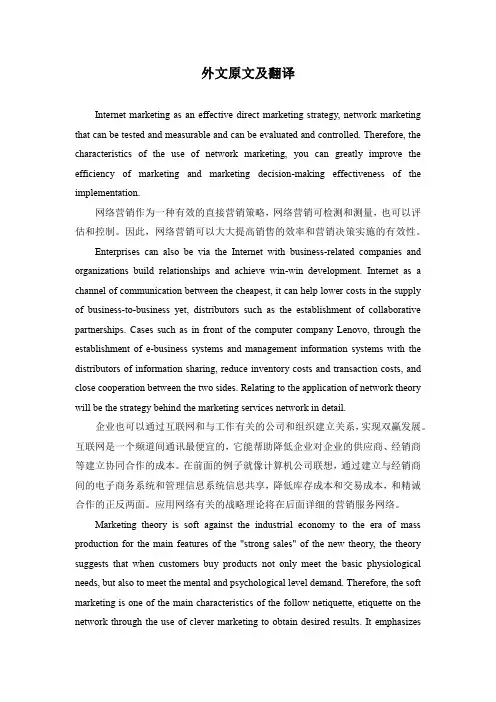
外文原文及翻译Internet marketing as an effective direct marketing strategy, network marketing that can be tested and measurable and can be evaluated and controlled. Therefore, the characteristics of the use of network marketing, you can greatly improve the efficiency of marketing and marketing decision-making effectiveness of the implementation.网络营销作为一种有效的直接营销策略,网络营销可检测和测量,也可以评估和控制。
因此,网络营销可以大大提高销售的效率和营销决策实施的有效性。
Enterprises can also be via the Internet with business-related companies and organizations build relationships and achieve win-win development. Internet as a channel of communication between the cheapest, it can help lower costs in the supply of business-to-business yet, distributors such as the establishment of collaborative partnerships. Cases such as in front of the computer company Lenovo, through the establishment of e-business systems and management information systems with the distributors of information sharing, reduce inventory costs and transaction costs, and close cooperation between the two sides. Relating to the application of network theory will be the strategy behind the marketing services network in detail.企业也可以通过互联网和与工作有关的公司和组织建立关系,实现双赢发展。
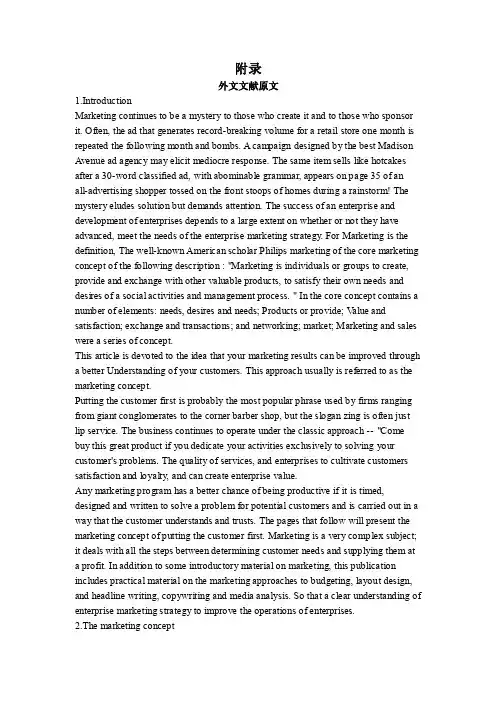
附录外文文献原文1.IntroductionMarketing continues to be a mystery to those who create it and to those who sponsor it. Often, the ad that generates record-breaking volume for a retail store one month is repeated the following month and bombs. A campaign designed by the best Madison Avenue ad agency may elicit mediocre response. The same item sells like hotcakes after a 30-word classified ad, with abominable grammar, appears on page 35 of anall-advertising shopper tossed on the front stoops of homes during a rainstorm! The mystery eludes solution but demands attention. The success of an enterprise and development of enterprises depends to a large extent on whether or not they have advanced, meet the needs of the enterprise marketing strategy. For Marketing is the definition, The well-known American scholar Philips marketing of the core marketing concept of the following description : "Marketing is individuals or groups to create, provide and exchange with other valuable products, to satisfy their own needs and desires of a social activities and management process. " In the core concept contains a number of elements: needs, desires and needs; Products or provide; V alue and satisfaction; exchange and transactions; and networking; market; Marketing and sales were a series of concept.This article is devoted to the idea that your marketing results can be improved through a better Understanding of your customers. This approach usually is referred to as the marketing concept.Putting the customer first is probably the most popular phrase used by firms ranging from giant conglomerates to the corner barber shop, but the slogan zing is often just lip service. The business continues to operate under the classic approach -- "Come buy this great product if you dedicate your activities exclusively to solving your customer's problems. The quality of services, and enterprises to cultivate customers satisfaction and loyalty, and can create enterprise value.Any marketing program has a better chance of being productive if it is timed, designed and written to solve a problem for potential customers and is carried out in a way that the customer understands and trusts. The pages that follow will present the marketing concept of putting the customer first. Marketing is a very complex subject; it deals with all the steps between determining customer needs and supplying them at a profit. In addition to some introductory material on marketing, this publication includes practical material on the marketing approaches to budgeting, layout design, and headline writing, copywriting and media analysis. So that a clear understanding of enterprise marketing strategy to improve the operations of enterprises.2.The marketing conceptMarket positioning is identifying the target market, enterprises will adopt what marketing methods, which provide products and services the target market and competitors to show distinction, thereby establishing corporate image and obtain favorable competitive position. Market positioning is a process of enterprise differentiation process, how to find the differences, identify differences and show differences. Today too many similar products, consumers how to choose Consumers buy what is the justification.On the effective positioning for a solution.Positioning is the first to propose in the advertising industry, advertising emphasized in the eyes of the public who left the location, And people often prefer preconceptions; If enterprises can target your customers mind to establish a definite position, to the consumer a reason to buy, enterprises can often compete in an advantageous position.Marketing is an economy built on science, behavioral science and modern management theory on the basis of applied sciences. It enterprise marketing activities and to study law,with full, comprehensive, practical features. As a modern enterprise "businesses" Marketing system introduced in the market economy under the conditions of the enterprises should have a sense of the market, business sense, Marketing strategies and methods. With China's economy growing prosperity, the market competition is becoming increasingly fierce; enterprises need Modern Marketing Theory as the guide. In the initial stage, a number of enterprises have marketing only as a help to product sales growth strategy and means If so far, many Chinese enterprises remain with the Department of Marketing with sales of two and one; When people realize that to meet the needs of the customer-oriented marketing concept should become an enterprise operating philosophy, and the enterprise's overall business activities have an impact, there will be a marketing position inappropriately increase the tendency For many people believe that marketing should be the decision-making levels of guiding ideology, rather than the level of implementation work. Marketing of the enterprise understanding of the position is not correct, will be marketing in the enterprise application will be affected. Marketing work is to open up markets, capture the market and expand the market work, enterprise development, and production activities should open up the market for services, a market that is the basis of the final services in the market. Marketing work is based on enterprise customers as the starting point for the reproduction process, and ensures the customer as the focus of the process of reproduction.That customer demand-oriented, according to the actual needs of customers developing marketable products, and targeted marketing of the market, and its sales to meet the needs of customers. With enterprises to become the main players in themarket, corporate marketing work more salient position, business leaders must attach great importance to it.Unfortunately, there is still a misunderstanding about the word marketing. Many people, including top executives, use it as a sophisticated term for selling. Marketing representative is commonly used in ads to recruit salespeople. Actually, marketing is a way of managing a business so that each critical business decision is made with full knowledge of the impact it will have on the customer.Here are some specific ways in which the marketing approach differs from the classic, or sales, approach to managing a business.①In the classic approach, engineers who develop the product and finally to engineers who produce it. Thus, the sales approach only ends with the customer, while the marketing approach begins and ends with the customer.②The second major difference between the sales and marketing approaches is the focus of management. The sales approach almost always focuses on volume while the marketing approach focuses on profit. In short, under the classic (sales) approach the customer exists for the business, while under the marketing approach the business exists for the customer.The marketing concept is a management plan that views all marketing components as part of a total system that requires effective planning, organization, leadership and control. It is based on the importance of customers to a firm, and states。
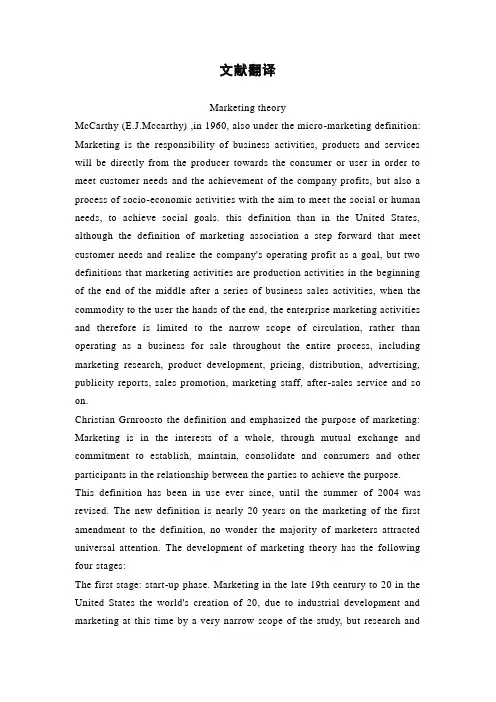
文献翻译Marketing theoryMcCarthy (E.J.Mccarthy) ,in 1960, also under the micro-marketing definition: Marketing is the responsibility of business activities, products and services will be directly from the producer towards the consumer or user in order to meet customer needs and the achievement of the company profits, but also a process of socio-economic activities with the aim to meet the social or human needs, to achieve social goals. this definition than in the United States, although the definition of marketing association a step forward that meet customer needs and realize the company's operating profit as a goal, but two definitions that marketing activities are production activities in the beginning of the end of the middle after a series of business sales activities, when the commodity to the user the hands of the end, the enterprise marketing activities and therefore is limited to the narrow scope of circulation, rather than operating as a business for sale throughout the entire process, including marketing research, product development, pricing, distribution, advertising, publicity reports, sales promotion, marketing staff, after-sales service and so on.Christian Grnroosto the definition and emphasized the purpose of marketing: Marketing is in the interests of a whole, through mutual exchange and commitment to establish, maintain, consolidate and consumers and other participants in the relationship between the parties to achieve the purpose. This definition has been in use ever since, until the summer of 2004 was revised. The new definition is nearly 20 years on the marketing of the first amendment to the definition, no wonder the majority of marketers attracted universal attention. The development of marketing theory has the following four stages:The first stage: start-up phase. Marketing in the late 19th century to 20 in the United States the world's creation of 20, due to industrial development and marketing at this time by a very narrow scope of the study, but research andcommercial advertising network settings. Island in Illinois and other related courses at the universities. By the "Association of American Advertising" to "National Advertising and Marketing Association of Science Teachers", to marketing research to ensure the organization. At this time of marketing research is characterized by: a. focus on marketing and advertising techniques, modern marketing theory, concepts, principles had yet to emerge; b. University research activities are basically confined to the classroom and a professor of the study, and also society and the business community did not receive attention.Phase II: Application stage. During the 20th century to the end of World War II 20 for the application stage, begun to take shape at this time, the United States began large-scale domestic enterprises to use marketing to operate businesses, open overseas markets, European countries have to follow. Established in 1931, "American Marketing Association" Marketing preach, and in 1937 merged the two organizations, academia and the business community to absorb a wide range to join the Marketing from the University of the rostrum to the community. This stage of the development of marketing in the applications. The capitalist world in 1929 due to the outbreak of an unprecedented economic crisis, the economy of the Great Depression, large shrinkage in the purchasing power of a sharp decline in the community, the unprecedented sharp market. The whole capitalist economic crisis dealt a serious blow. This stage, marketing research is characterized by: a. there is no product to sell out of this narrow concept of; b. at a deeper study on the basis of a broader marketing and advertising technique; c. study in favor of selling the business organization set; d. beginning of the study of marketing theory to society, paying attention to the general business community.The third phase: the formation period of development. The 20th century, the 50's to 80's for the marketing stage of development, the U.S. military-industrial economy has begun to shift the public economic, social goods, the sharp increase in social productivity improved significantly, while the corresponding consumption level of residents has not been muchimprovement, market began to emerge in a state of oversupply. At this point the U.S. marketing expert R. Cox and W. Aderson the "broad sense of Marketing is to promote the potential producers and consumers of goods or services of any transaction activity." This point of view to make the start into the new marketing stage. Previously that the market is the end of the production process, is now considered to be the starting point of the production process; the original that is marketing to sell products, now that marketing through the investigation to understand the needs and desires of consumers, and production in line with consumer needs and desires goods or services, which meet the needs and desires of consumers; so that from the marketing companies to enter the framework of social vision and a clear management guidance.Phase IV: the mature stage. Since the 80's for the marketing of the mature stage, in: a. associated with other disciplines such as economics, mathematics, statistics, psychology, etc.; b. theory began to form their own system; 80 is the age of marketing revolutionary period, begun to enter the field of modern marketing, so marketing the new look.译文市场营销理论麦卡锡(E.J.Mccarthy)于1960年对微观市场营销下了定义:市场营销是企业经营活动的职责,它将产品及劳务从生产者直接引向消费者或使用者以便满足顾客需求及实现公司利润,同时也是一种社会经济活动过程,其目的在于满足社会或人类需要,实现社会目标。
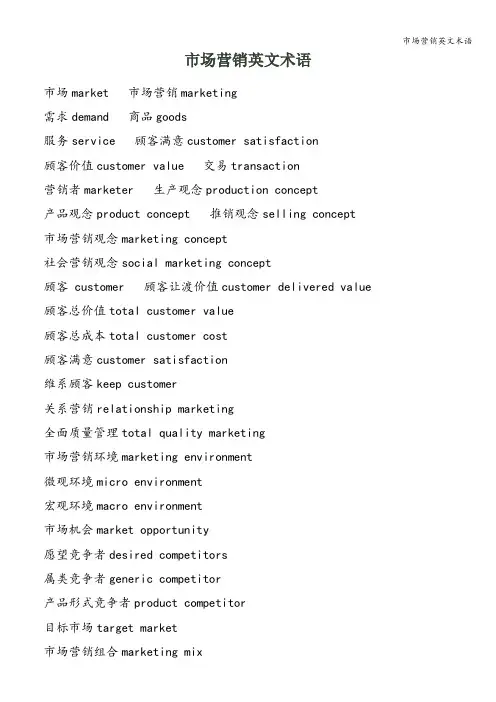
市场营销英文术语市场market 市场营销marketing需求demand 商品goods服务service 顾客满意customer satisfaction顾客价值customer value 交易transaction营销者marketer 生产观念production concept产品观念product concept 推销观念selling concept市场营销观念marketing concept社会营销观念social marketing concept顾客 customer 顾客让渡价值customer delivered value 顾客总价值total customer value顾客总成本total customer cost顾客满意customer satisfaction维系顾客keep customer关系营销relationship marketing全面质量管理total quality marketing市场营销环境marketing environment微观环境micro environment宏观环境macro environment市场机会market opportunity愿望竞争者desired competitors属类竞争者generic competitor产品形式竞争者product competitor目标市场target market市场营销组合marketing mix情绪moods 情绪emotion消费者行为customer behavior文化culture 人口统计因素demographies参照群体reference group 角色模型role stereotype知觉perception 认知学习cognitive learning动机motive 个性personality态度attitude 自我概念self-concept生活方式life style组织市场organizational market企业市场business market非营利组织市场non-profit organizational market政府市场government market直接再购straight rebuy 修正再购 modified rebuy新任务采购new task 购买中心buying center倡议者initiators 使用者users 影响者influencers 决定者deciders 购买者buyers 控制者gatekeepers 营销信息marketing information营销信息系统marketing information system MIS市场调研market research描述性调研predictive research解释性调研interpretive research市场需求market demand市场需求潜量market demand potential企业需求量enterprise demand企业需求潜量enterprise demand potential定性预测qualitative forecasting定量预测quantitative forecasting企业战略enterprise strategy企业使命说明书enterprise statement战略经营单位strategy business units,SBU波士顿矩阵Boston matrix通用电器公司方法the General Electric Model,GE市场吸引力market attractiveness业务实力business attractiveness密集型增长战略intensive growth strategies市场渗透market penetration strategy市场开发market development strategy产品开发product development strategy一体化增长战略integrative growth strategies前向一体化forward integration后向一体化backwards integration水平一体化horizontal integration多角化增长战略diversification growth strategies 同心多角化concentric diversification水平多角化horizontal diversification复合多角化conglomeration diversification市场营销战略marketing strategy市场营销组合marketing mix市场营销组织marketing organization职能型组织functional organization地区型组织regional organization产品管理型组织managerial organization of product市场管理型组织managerial organization of market公司与事业部型组织organization of corporation andbusiness unit市场营销管理marketing management市场营销计划marketing planning市场营销方案marketing program市场营销控制marketing controlling市场竞争market competition完全竞争pure competition非完全竞争imprecate competition垄断竞争monopolistic competition市场领导者market leader 市场挑战者market challenger 市场追随者market follower 市场补缺者marketing niche 市场细分market segmentation目标市场target market市场定位market positioning无差异性市场策略undifferentiated marketing tactics 差异性市场策略differentiated marketing tactics集中性市场策略concentrated marketing tactics产品product 服务service核心产品core product 形式产品actual product期望产品expected product 延伸产品augmented product 潜在产品potential product 耐用品durable goods非耐用品nondurable goods 产品线product line产品项目product item 产品组合product mix产品组合长度product mix length产品组合宽度product mix width产品组合深度product mix depth产品组合关联度product mix consistency产品生命周期product life cycle开发期development stage 引进期introduction stage 成熟期maturity stage 衰退期decline stage新产品开发new product development产品概念product concept商业化commercialization 包装package包装策略package strategy品牌brand 品牌命名brand naming品牌决策branding decision统一品牌blanket family brand品牌使用者决策brand-sponsor decision个别品牌individual brand分类品牌separate family brand多品牌multi—brand统一的个别品牌company/individual brand合作品牌co—branding 品牌设计brand designing品牌资产brand equity 品牌延伸brand extension内涵不变式延伸invariable meaning extension内涵渐变式延伸gradual changing meaning extension品牌管理brand management竞争导向定价competition-driven pricing折扣定价discount pricing地区定价region pricing差别定价discrimination pricing撇脂定价skim pricing 渗透定价penetration pricing 满意定价neutral pricing 尾数定价mantissa pricing 整数定价integer pricing 招徕定价fetch—in pricing 声望定价prestige pricing目标收益定价法target—return pricing认知价值定价法perceived-value pricing价值定价法value pricing通行价格定价法going-rate pricing分销渠道distribution channel 中间商intermediate 分销渠道设计distribution channel design实体分配physical distribution渠道冲突channel conflictcha15 促销策略促销promotion 促销策略promotion policies理性诉求rational appeals 情感诉求emotional appeals 道德诉求moral appeals大众传播媒体mass media 气氛atmosphere事件event 量力支出法affordable method销售额百分比法percentage-of-sales method竞争对等法competitive-parity method目标任务法objective-task method广告advertising 人员推销personal selling公共关系public relations 营业推广sales promotion 促销组合promotion mix推动策略push strategy 拉引策略pull strategy广告目标mission 告知性广告information advertising 劝告性广告persuasive advertising提示性广告reminder advertising整合营销传播integrated marketing communication服务service 服务核心产品core product服务附加产品supplement product服务的无形性intangibility of service服务体验属性experience attributes服务的信任度属性credence attributes服务的有形展示physical evidence关系营销relationship marketing体育营销sports marketing网络营销network marketing会展营销exhibition marketing文化营销cultural marketing。
市场营销英语词汇市场营销英语词汇一、市场分析1.市场研究:market research2.调查问卷:survey questionnaire3.竞争对手:competitors4.市场调查:market survey5.消费者需求:consumer demand6.目标市场:target market7.市场规模:market size8.市场份额:market share9.市场细分:market segmentation10.市场定位:market positioning11.市场的机会:market opportunities12.市场威胁:market threats13.市场趋势:market trends14.市场前景:market prospects二、营销策略1.品牌认知:brand awareness2.品牌忠诚度:brand loyalty3.营销策略:marketing strategy4.产品定位:product positioning5.市场定位:market positioning6.目标市场:target market7.竞争优势:competitive advantage8.市场份额:market share9.销售额:sales revenue10.广告费用:advertising costs11.营销预算:marketing budget12.营销组合:marketing mix13.产品价格策略:product pricing strategy14.市场推广策略:marketing promotion strategy15.营销渠道:marketing channels16.口碑营销:word-of-mouth marketing17.网络营销:digital marketing三、销售管理1.销售经理:sales manager2.销售团队:sales team3.销售目标:sales target4.销售预测:sales forecast5.销售数据:sales data6.销售报告:sales report7.销售额:sales revenue8.销售人员绩效:sales performance9.销售技能培训:sales training10.销售策略:sales strategy11.销售渠道:sales channels12.销售推广:sales promotion13.销售方式:sales method14.市场营销:marketing and sales四、客户关系管理1.客户满意度:customer satisfaction2.客户需求:customer needs3.客户关怀:customer care4.客户忠诚度:customer loyalty5.客户服务:customer service6.客户关系管理:customer relationship management7.客户开发:customer development8.增加客户:acquire new customers9.保持客户:retain customers10.客户反馈:customer feedback11.客户投诉:customer complaints12.客户体验:customer experience13.生命周期价值:lifetime value14.客户分类:customer segmentation五、品牌管理1.品牌形象:brand image2.品牌建设:brand building3.品牌价值:brand value4.品牌忠诚度:brand loyalty5.品牌定位:brand positioning6.品牌延伸:brand extension7.品牌重塑:brand repositioning8.品牌保护:brand protection9.品牌战略:brand strategy10.品牌知名度:brand awareness11.品牌差异化:brand differentiation12.品牌推广:brand promotion13.品牌严格控制:brand equity14.品牌形象修复:brand image repair六、新产品开发1.产品开发:product development2.产品创新:product innovation3.产品设计:product design4.产品测试:product testing5.市场测试:market testing6.产品定价:product pricing7.产品包装设计:product packaging design8.产品发布:product launch9.产品开发流程管理:product development process management10.产品研究:product research11.产品管理:product management12.产品线策略:product line strategy13.产品生命周期:product life cycle14.产品特点:product features总结以上是关于市场营销英语词汇的介绍,通过了解这些词汇,可以帮助我们了解市场营销的基本知识和规律,从而更好地制定和实施营销战略,提高企业的竞争力和市场占有率。
市场营销专业毕业论文中英文资料外文翻译文献毕业论文中英文资料外文翻译文献文献翻译原文Marketing theoryMcCarthy (E.J.Mccarthy) ,in 1960, also under the micro-marketingdefinition: Marketing is the responsibility of business activities, products and services will be directly from the producer towards the consumer or userin order to meet customer needs and the achievement of the company profits,but also a process of socio-economic activities with the aim to meet thesocial or human needs, to achieve social goals. this definition than in the United States, although the definition of marketing association a step forward that meet customer needs and realize the company's operating profit as a goal, but two definitions that marketing activities are production activities in the beginning of the end of the middle after a series of business sales activities, when the commodity to the user the hands of the end, the enterprise marketing activities and therefore is limited to the narrow scope of circulation, rather than operating as a business for sale throughout the entire process, including marketing research, product development, pricing, distribution, advertising, publicity reports, sales promotion, marketing staff, after-sales service andso on.Christian Grnroosto the definition and emphasized the purpose of marketing: Marketing is in the interests of a whole, through mutual exchange and commitment to establish, maintain, consolidate and consumers and other participants in the relationship between the parties to achieve the purpose. This definition has been in use ever since, until the summer of 2021 was revised. The new definition is nearly 20 years on the marketing of the first amendment to the definition, no wonder the majority of marketers attracteduniversal attention. The development of marketing theory has the following four stages:The first stage: start-up phase. Marketing in the late 19th century to 20 in the United States the world's creation of 20, due to industrial development and marketing at this time by a very narrow scope of the study, but research and commercial advertising network settings. Island in Illinois and other related courses at the universities. By the \of American Advertising\to\Advertising and Marketing Association of Science Teachers\to marketing research to ensure the organization. At this time of marketing research is characterized by: a. focus on marketing and advertising techniques, modern marketing theory, concepts, principles had yet to emerge; b. University research activities are basically confined to the classroom and a professor of the study, and also society and the business community did not receive attention.Phase II: Application stage. During the 20th century to the end of World War II 20 for the application stage, begun to take shape at this time, the United States began large-scale domestic enterprises to use marketing to operate businesses, open overseas markets, European countries have to follow. Established in 1931, \Marketing Association\Marketing preach, and in 1937 merged the two organizations, academia and the business community to absorb a wide range to join the Marketing from the University of the rostrum to the community. This stage of the development of marketing in the applications. The capitalist world in 1929 due to the outbreak of an unprecedented economic crisis, the economy of the Great Depression, large shrinkage in the purchasing power of a sharp decline in the community, the unprecedented sharp market. The whole capitalist economic crisis dealt a serious blow. This stage, marketing research is characterized by: a. there is no product to sell out of this narrow concept of; b. at a deeper study on the basis of a broader marketing and advertising technique; c. study in favor of selling the business organization set; d. beginning of the study of marketing theory to society, paying attention to the general business community.The third phase: the formation period of development. The 20th century, the 50's to 80's for the marketing stage of development, the U.S. military-industrial economy has begun to shift the public economic, social goods, the sharp increase in social productivity improved significantly, while the corresponding consumption level of residents has not been much improvement, market began to emerge in a state of oversupply. At this point the U.S. marketing expert R. Cox and W. Aderson the \sense of Marketing is to promote the potential producers and consumers of goods or services of any transaction activity.\the new marketing stage. Previously that the market is the end ofthe production process, is now considered to be the starting point of the production process; the original that is marketing to sell products, now that marketing through the investigation to understand the needs and desires of consumers, and production in line with consumer needs and desires goods or services, which meet the needs and desires of consumers; so that from the marketing companies to enter the framework of social vision and a clear management guidance.Phase IV: the mature stage. Since the 80's for the marketing of the mature stage, in: a. associated with other disciplines such as economics, mathematics, statistics, psychology, etc.; b. theory began to form their own system; 80 is the age of marketing revolutionary period, begun to enter the field of modern marketing, so marketing the new look.译文市场营销理论麦卡锡(E.J.Mccarthy)于1960年对微观市场营销下了定义:市场营销是企业经营活动的职责,它将产品及劳务从生产者直接引向消费者或使用者以便满足顾客需求及实现公司利润,同时也是一种社会经济活动过程,其目的在于满足社会或人类需要,实现社会目标。
外文文献翻译Nike, lining, for everyone, is a familiar sports brand. In the United States, have high amounted to 70% Teen Dream is to have a pair of Nike shoes. Lining is the China sporting goods industry leader. In this paper we will from Nike, Nike lining lining the development the core value to discuss the lining and Nike in the cultural difference.We then aiming at the Nike lining the politics, economy, culture, technology and other aspects of the macroscopic environment analysis. In the brand positioning, Nike and lining are only used a self-expression positioning, Nike 's slogan is" Just do it", lining was replaced with a new slogan" Make the Change ( make change happen )" replaced the original" Anything is possible ( everything is possible. )".There is also the opportunity to develop products such as sport wear, sunglasses and jewellery. Such high value items do tend to have associated with them, high profits. The business could also be developed internationally, building upon its strong global brand recognition. There are many markets that have the disposable income to spend on high value sports goods. For example, emerging markets such as China and India have a new richer generation of consumers. There are also global marketing events that can be utilised to support the brand such as the World Cup (soccer) and The Olympics.Product development offers Nike many opportunities. The brand is fiercely defended by its owners whom truly believe that Nike is not a fashion brand. However, like it or not, consumers that wear Nike product do not always buy it to participate in sport. Some would argue that in youth culture especially, Nike is a fashion brand. This creates its own opportunities, since product could become unfashionable before it wears out i.e. consumers need to replace shoes.Lining, Nike is take self-expression way of positioning, can exhibit the unique brand image, promote a unique personality, so that the brand has become the expression of consumer personal values, self expression of a carrier and media. Lining and Nike target customers are young people, is a similar consumer groups. But they all have their own one is from the United States foreign brands, is a domestic national brand is they can be successful, because they are used for their own variouspositioning and marketing strategies.The market for sports shoes and garments is very competitive. The model developed by Phil Knight in his Stamford Business School days (high value branded product manufactured at a low cost) is now commonly used and to an extent is no longer a basis for sustainable competitive advantage. Competitors are developing alternative brands to take away Nike's market share.As discussed above in weaknesses, the retail sector is becoming price competitive. This ultimately means that consumers are shopping around for a better deal. So if one store charges a price for a pair of sports shoes, the consumer could go to the store along the street to compare prices for the exactly the same item, and buy the cheaper of the two. Such consumer price sensitivity is a potential external threat to Nike.If you have a body, you are an athlete - Bill Bowerman said this a couple of decades ago. The guy was right. It defines how he viewed the world, and it defines how Nike pursues its destiny. Ours is a language of sports, a universally understood lexicon of passion and competition. A lot has happened at Nike in the 30 years More ……So we discussed below lining Nike market positioning and their respective market differentiation strategy. It is because they each find themselves in the market are in the best position and strategy, it is the two brand to become the leader of the important reasons.李宁、耐克都是采取自我表现的定位方式,可以展示品牌的独特形象,宣扬独特个性,让品牌成为消费者表达个人价值观、表现自我的一种载体和媒介。
原文: Coke CEO: We will be stronger than before ——Energy drinks still buzzing in Europe :Mainstream appeal Coca-Cola Chief Executive Muhtar Kent said Friday that the world's biggest beverage company would emerge from the global financial crisis stronger than it went in. "In a funny way, as I've said, there are many opportunities: We will not waste this crisis," he told financial analysts at the Consumer Analyst Group of New York conference. "We feel we will emerge out of this stronger." Kent also said advertising dollars are more powerful in this environment, and the company planned to keep spending to promote its brands. "The airwaves are cleaner, the cost of advertising is much lower," Kent said. "You get much better bang for your buck, in terms of how you reach consumers." In addition to trademark Coke, the company sells Sprite, Fanta, VitaminWater, Dasani bottled water and Minute Maid orange juice. Atlanta-based Coke launched a new global marketing campaign last month that is running simultaneously with a push by PepsiCo Inc., the second biggest beverage maker. Industry watchers say the ad blitzes are designed to lure American consumers back to soft drinks, a cheap indulgence that appeals to shoppers who want to spend less. "We deliver simple moments of pleasure," Kent said. Coca-Cola Co. and PepsiCo, based in Purchase, N.Y., both have said their focus will be to turn around the market for soda in North America. Soft drink sales have been in decline for years as consumers grew concerned about the high-fructose corn syrup that sweetened the drinks. The drinks makers hope innovations like stevia-based sweetener will help stem falling sales and eventually bring revenue growth back in line with population growth. Both have also introduced 16-ounce drink sizes to be sold for 99 cents. Shares of Coke fell 35 cents to $42.95 in midday trading while PepsiCo shares fell 45 cents to $51.75. Category fatigue that has blighted other segments of the beverage industry such as bottled water and carbonated drinks, is not affecting energy drinks which continue to draw in more and more users. Figures on the drinks scene in Western Europe compiled by beverage market analyst, Zenith International, reveal a market valued at €3.76m in 2007, with growth at 11 per cent over the previous year, for a total of 487m litres. Sales would broach 700m litres in 2012. There are no signs of a slow-down as consumer acceptance of energy drinks builds. Zenith predicts growth of eight per cent for the next five years. Multi-billion selling, category pioneer, Red Bull, will continue to dominate sales in Western Europe – it continues to hold about 60 per cent of the market – and Zenith gives no indication that this will change any time soon, despite increased competition. Red Bull is sold in more than 140 countries and the slimline can format it pioneered remains the package of choice across all brands although Coke‘s Relentless and others come in other shapes and varieties such as a 500ml can Relentless comes in. Coca-Cola‘s Burn had overtaken Shark to take second place, with MBG International Premium Brands-owned Effect in third and Relentless the fifth highest seller. ―Intensifying competition, effective marketing support and increased consumer acceptance as well as loyalty have been key contributors to current growth,‖ said Zenith market intelligence director, Gary Roethenbaugh. ―Manufacturers have been extending distribution and developing more mainstream appeal, targeting a wider range of consumer groups. This has resulted in a shift of emphasis towards the retail channel.‖ The top 10 brands accounted for 75 per cent of sales, Zenith found, with taurine and caffeine products making up 74 per cent of products. The UK, Germany and Spain accounted for 56 per cent of West European volume, while France, which recently permitted taurine as an ingredient after banning it for many years, was the fastest growing market. Ireland, Denmark and Spain also demonstrated rapid growth, albeit from varying volume levels. Ireland had the highest consumption per person at 7.7 litres, followed by Austria and Switzerland on 5.4 litres and 2.4 litres respectively.